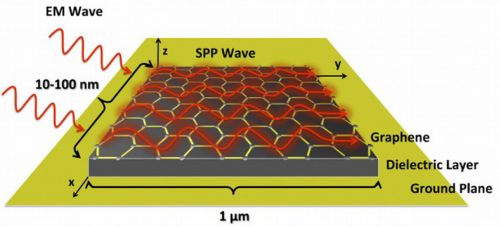Graphene, I am sure, is one of the most sought after materials for researchers across the world today. Just two months back we shed light on how graphene will be replacing silicon in the chips creating revolution in the field of semiconductors and then we talked about the new annealing treatment that might take graphene to the next level. Still curious for more, researchers at the Georgia Institute of Technology claim that they have devised a mechanism through which they can extent the capability of nanoscale antennas fabricated from graphene unlike the conventional metallic components.
Traditional connecting material like copper makes the connections between low powered nanomachines nearly impossible. However, this is not the case with graphene because of its unique electronic properties. It requires extremely less energy for operation plus, its honeycomb structure is an added advantage as it helps in producing an electronic surface wave.
The researchers are trying to bring about the desired effect through the piezoelectric quality of graphene, that is, when an electromagnetic wave is introduced to it, the electrons get excited and start to propagate creating an oscillation of charge, consequent upon which electromagnetic wave or the surface plasmon polariton (SPP) wave is produces at the surface level. This makes the graphene-based nanoantennas to function at the low end of the terahertz frequency range, between 0.1 and 10 terahertz.
It has been observed that metals such as gold too can produce an SPP but the frequency is higher relatively, which does not make it a contender for the nanoantennas.
Josep Jornet, a graduate student at the time of the research and now an assistant professor at the State University of New York at Buffalo said,
With this antenna, we can cut the frequency by two orders of magnitude and cut the power needs by four orders of magnitude. Using this antenna, we believe the energy-harvesting techniques developed by Dr. Wang would give us enough power to create a communications link between nanomachines.
The concept does sound promising since the practical applications is yet to be demonstrated but the modeling and simulations confirms that nano-networks using the new approach are feasible with the alternative material. As said by one of the lead researcher, graphene will definitely emerge as one of the powerful material in the nanomarket dominating the next half of ensuing century.




